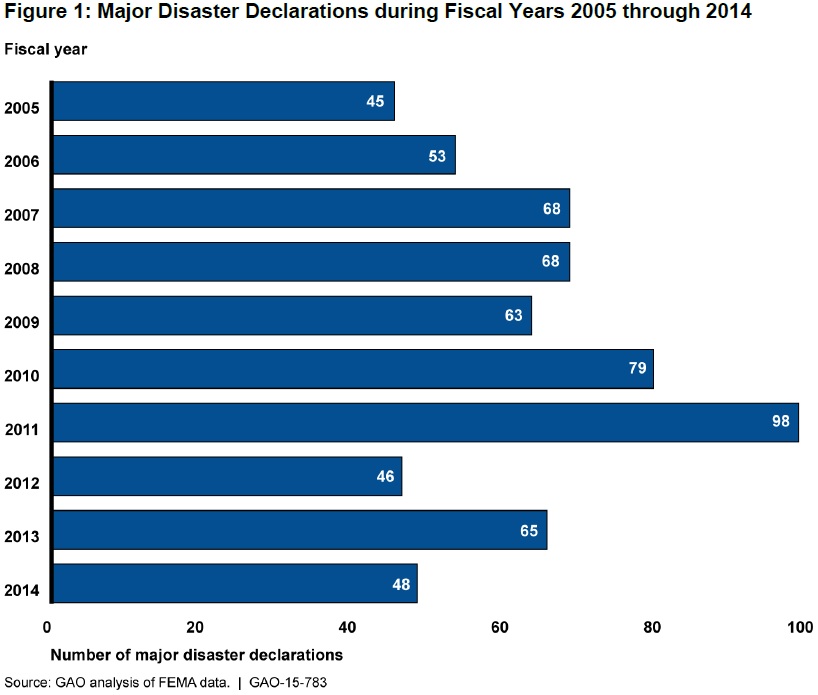Contracting during a Disaster: Lessons Learned from Hurricanes Katrina and Sandy
When disaster strikes, the Federal Emergency Management Agency can help. But FEMA doesn’t do it all on its own. The agency contracts for goods, like meals and cots for disaster survivors, as well as services, like translators and housing inspectors.
Three years after Hurricane Sandy, one of the largest natural disasters in our nation’s history, today’s WatchBlog focuses on the importance of contracting during a disaster, and some of its inherent challenges.
Emergency shopping
It’s hard to predict the size, frequency, or type of natural disasters that will occur in a given year. For example, in 2012, the year Hurricane Sandy hit, there were less than half as many major disaster declarations than there had been in 2011.
 (Excerpted from GAO-15-783)
(Excerpted from GAO-15-783)
Once disaster strikes, FEMA may not know exactly what it needs to respond. Is the most pressing issue providing electric generators, or food and blankets? Further, early estimates of damage may change or grow over a multi-day disaster.
In the midst of all this uncertainty, FEMA has to balance providing disaster relief in a timely manner with following federal contracting regulations. These regulations—such as requiring bids from multiple businesses—can help FEMA save money on contracts and safeguard taxpayer dollars.
FEMA also tries to award contracts to local vendors to further help a region’s recovery efforts. However, sometimes they encounter businesses that are new to federal contracting.
Learning from experience
Following Hurricane Katrina in 2005, FEMA took steps to address some of its disaster contracting problems. For example, FEMA tripled the size of its contracting workforce, who are often on the front lines to buy needed items and services when disaster strikes.
 (Excerpted from GAO-15-783)
(Excerpted from GAO-15-783)
To help expedite disaster contracting, FEMA also established advance contracts. This way, FEMA can agree to purchase disaster-related items from specific vendors, but can wait until the disaster actually happens to specify all the details, such as precise quantities.
In addition, FEMA has focused on building relationships with local vendors to make it easier to award them contracts during a disaster.
And yet…
We found that for each of the steps FEMA took, there was more to be done. FEMA needs to ensure that its newer and more inexperienced contracting staff are ready and able to respond to situations as intense as Katrina and Sandy. Some FEMA contracting staff weren’t aware of all the existing advance contracts. And some contracting officers didn’t understand the rules for awarding contracts to local vendors.
We made multiple recommendations and FEMA agreed to take steps to help build its capacity to respond to future disasters.
- Questions on the content of this post? Contact Michele Mackin at mackinm@gao.gov.
- Comments on GAO’s WatchBlog? Contact blog@gao.gov.
GAO Contacts
Related Products

GAO's mission is to provide Congress with fact-based, nonpartisan information that can help improve federal government performance and ensure accountability for the benefit of the American people. GAO launched its WatchBlog in January, 2014, as part of its continuing effort to reach its audiences—Congress and the American people—where they are currently looking for information.
The blog format allows GAO to provide a little more context about its work than it can offer on its other social media platforms. Posts will tie GAO work to current events and the news; show how GAO’s work is affecting agencies or legislation; highlight reports, testimonies, and issue areas where GAO does work; and provide information about GAO itself, among other things.
Please send any feedback on GAO's WatchBlog to blog@gao.gov.




